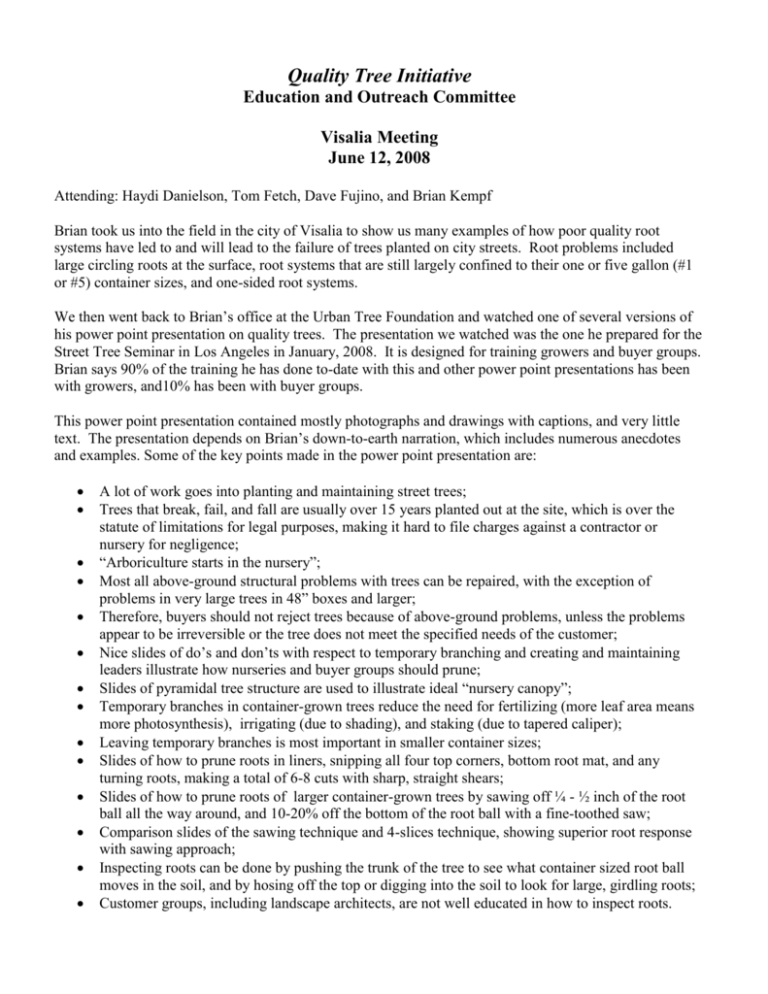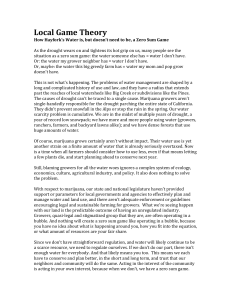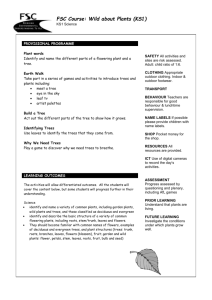Quality Tree Initiative
advertisement

Quality Tree Initiative Education and Outreach Committee Visalia Meeting June 12, 2008 Attending: Haydi Danielson, Tom Fetch, Dave Fujino, and Brian Kempf Brian took us into the field in the city of Visalia to show us many examples of how poor quality root systems have led to and will lead to the failure of trees planted on city streets. Root problems included large circling roots at the surface, root systems that are still largely confined to their one or five gallon (#1 or #5) container sizes, and one-sided root systems. We then went back to Brian’s office at the Urban Tree Foundation and watched one of several versions of his power point presentation on quality trees. The presentation we watched was the one he prepared for the Street Tree Seminar in Los Angeles in January, 2008. It is designed for training growers and buyer groups. Brian says 90% of the training he has done to-date with this and other power point presentations has been with growers, and10% has been with buyer groups. This power point presentation contained mostly photographs and drawings with captions, and very little text. The presentation depends on Brian’s down-to-earth narration, which includes numerous anecdotes and examples. Some of the key points made in the power point presentation are: A lot of work goes into planting and maintaining street trees; Trees that break, fail, and fall are usually over 15 years planted out at the site, which is over the statute of limitations for legal purposes, making it hard to file charges against a contractor or nursery for negligence; “Arboriculture starts in the nursery”; Most all above-ground structural problems with trees can be repaired, with the exception of problems in very large trees in 48” boxes and larger; Therefore, buyers should not reject trees because of above-ground problems, unless the problems appear to be irreversible or the tree does not meet the specified needs of the customer; Nice slides of do’s and don’ts with respect to temporary branching and creating and maintaining leaders illustrate how nurseries and buyer groups should prune; Slides of pyramidal tree structure are used to illustrate ideal “nursery canopy”; Temporary branches in container-grown trees reduce the need for fertilizing (more leaf area means more photosynthesis), irrigating (due to shading), and staking (due to tapered caliper); Leaving temporary branches is most important in smaller container sizes; Slides of how to prune roots in liners, snipping all four top corners, bottom root mat, and any turning roots, making a total of 6-8 cuts with sharp, straight shears; Slides of how to prune roots of larger container-grown trees by sawing off ¼ - ½ inch of the root ball all the way around, and 10-20% off the bottom of the root ball with a fine-toothed saw; Comparison slides of the sawing technique and 4-slices technique, showing superior root response with sawing approach; Inspecting roots can be done by pushing the trunk of the tree to see what container sized root ball moves in the soil, and by hosing off the top or digging into the soil to look for large, girdling roots; Customer groups, including landscape architects, are not well educated in how to inspect roots. After watching the presentation, we identified the following concerns: Insufficient research has been done on the long term value of root pruning in containerized plants; Insufficient research has been done on preferred root pruning techniques in a production nursery setting; There is no significant statistical difference in top growth between trees that are root pruned and those that are not root pruned (A small test of 45 trees of one species has been done, but results are not conclusive at this point.); Careful root pruning at the time of every transplanting (L, 1, 5, 15, 24, etc.) will cost most nurseries more in labor, depending on current root pruning practices; Growers feel they need to be able to pass the added production costs for producing higher quality trees on to their customers; At this time, it seems unlikely that growers will be able to demand a higher price for trees with better root structure, given the competitive nature of the market and the priorities of the majority of our buyers. A good deal of customer education will be required before this changes; Most buyers pay little attention to the root systems of trees, unless there are obvious problems; Everyone needs to be aware that there will be a transition period of 5+ years; A little information can be dangerous, so buyers who receive 60 minutes of training and consider themselves to be experts can do a lot of damage. Training and research are critical. And the following opportunities: California can lead the nation in BMP’s for producing quality trees, especially in the area of quality root systems; Working with the entire green industry as a team: propagators, bare root growers, container growers, landscape contractors, landscape architects, arborists, and municipal workers can yield long-term benefits and a win-win for all stakeholders; Container choices may help root structure: bottomless TP’s, squatty containers; If growers establish the standards and set up a structure to self-regulate, we can avoid state government regulation; Regulations can be instrumental in creating an environment in which growers who meet the standards are rewarded with higher prices. Research, both basic and applied. The benefits to growers of producing quality trees, including root systems, include: Growers can reduce dumps or scrap; Growers and buyer groups can reduce rework, by doing it right the first time; Growers can reduce rejections; Growers can reduce time spent sorting, selecting, and inspecting trees; Growers can improve their reputations; Growers may be able to save on water, fertilizer, and tree stakes; Growers may be able to command a premium price for a quality tree; Growers can be instrumental in raising the quality standard for trees throughout the industry. Next step suggestions: Brian to continue making presentations to grower and buyer groups, including the caveat that research on roots to-date is limited; Begin research on root pruning at various production stages in container tree nurseries, whether through university, a UTF grant, or at our individual nursery sites (techniques, risks, do’s and don’ts); Do a cost analysis of root pruning at every stage of transplanting; Begin researching methods of improving root performance in the landscape by: watering at the drip line vs. at the trunk, digging irregular vs. round compacted holes for planting, pruning roots at the time of planting, and taking the boxes off of trees before planting; Get growers and buyers to work together by forming focus groups to brainstorm the subject of quality trees and roots and the cost of quality; Develop a grower workshop program, including curriculum and schedule, to educate growers on BMP’s for producing high quality trees with established leaders, temporary branching, and, given current knowledge, improved root systems; Once research on root pruning in production nurseries yields conclusive results, and growers determine a way to bear the added costs, create a training video, in English and Spanish, for use by nursery growers to train their production employees and sales staff in BMP’s.






